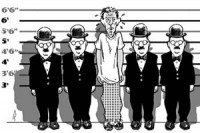
As mentioned in the earlier post it is crucial to pay attention to the types of customers your business wants to attract. Most small business owners do not pay sufficient attention to this subject and end up leaving money on the table or not making money at all, as a result. That is why it is important to not try to sell everything to everyone and instead think about what types of customers are the right fit for your business.
But how do you go about finding the “right” customers? We think this should be a two-step process. First you should think introspectively about your business and then identify what types of customers will be attracted by the value offered by your business. We explained these steps in detail below.
Step 1 (Business Understanding) – Before you can think about your customers you need to understand your own business. What does your business sell (and we don’t mean the actual products, but value)? What does it stand for? Do you want to be low price leader or high value purveyor? Does your business want to adopt self-serve model or high-touch customer service? Should you focus on top-notch quality or just good enough is good enough? All these questions should help you identify the value your business brings to the customers and help you identify those customers in the next step.
Remember, in this analysis one option is not necessarily better than other. Both options could be equally legitimate on its own, but you can’t have your cake and eat it too! Wal-Mart, the low price leader, cannot aim to attract Tiffany customers and Tiffany should not try to sell it jewelry at low price.
Step 2 (Customer Identification) – Once you have determined the value your business provides to customers the next step is identify the customers that would be attracted by it. This is commonly referred to as customer segmentation and can be done based on multiple factors. Typically, businesses look at the customer demographics such as age, income, family, etc. to assign the customers in different segments. While this may work fine, a better way to identify the target customers is by looking for the “persona” of customers that are likely to be drawn to the value you provide.
Here is an example – Let’s say you own a restaurant and want to focus on ready-to-eat meal that is made fresh and delivered to customers quickly. What type of customers will be attracted by this value proposition? We think your typical customer will be a health-conscious family with young kids, with both parents working. In short, a family that does not have time to cook in the evening, but doesn’t want to eat “junk” food served by fast-food restaurants. As you can see indentifying customer segments based on “persona” yields better results in customer segmentation.
One word of caution… Once you have determined the right customers make sure all parts of your business work in harmony to provide the value your customers are looking for. Failing to do so will only confuse customers and hurt your business. Stand by to see what this means till next post.
Related posts:






